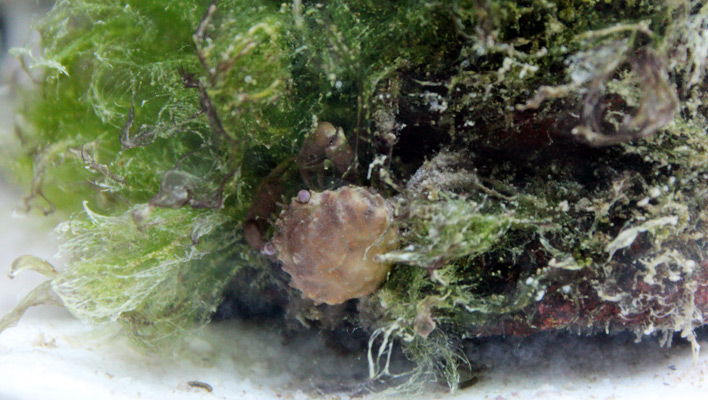Of all the irksome algae that can take hold in a saltwater aquarium, hair algae probably causes hobbyists more consternation than any other. So named for its hair-like, furry, or feathery appearance, this filamentous algae (for the sake of simplicity, I’ll use “algae” for both the singular and plural forms of the noun) is primarily an aesthetic issue in fish-only aquariums, but in reef systems, it can quickly overgrow and smother corals, turning a once thriving system into a tangled, unsightly mess.
Like most troublesome algae, hair algae thrives in systems with elevated levels of dissolved nutrients—i.e., nitrate and phosphate (think: fertilizer). In intensely illuminated reef systems with excess dissolved nutrients, the proliferation of hair algae can be positively explosive! However, even reasonably well maintained systems that aren’t powerfully lighted can see their share of this nuisance algae if the balance tips even slightly in favor of its growth.
So, what should you do if hair algae rears its ugly, scruffy head in your system?
Prepare to be patient!
As the old saying goes, only bad things happen quickly in marine aquariums. While it’s wise to take prompt action against hair algae when it manifests itself, don’t expect to eradicate it overnight. Also, don’t assume a single action or technique will get rid of this gunk. Successful management usually requires a sustained, multi-pronged approach.
Feed and stock sparingly
Rarely do sparsely stocked and appropriately fed marine aquariums experience major algae blooms. On the other hand, overstocked and heavily fed systems are always on the ragged edge of nutrient overload. Basically, they’re nitrate/phosphate factories. One of your first steps should be to evaluate whether it might behoove you to relocate some specimens and/or cut back on the volume or frequency of feeding.
Rule out your tap water and salt mix as a contributing factor
Two other common ways nitrate and phosphate enter aquarium systems is via tap water and synthetic sea salt mixes. Purifying your tap water with a reverse-osmosis/deionizing (RO/DI) unit will ensure these nutrients (if present) are removed before you use the tap water to compensate for evaporation or to mix up clean salt water for water changes.
To ensure your synthetic sea salt mix isn’t the source, be sure to purchase a reputable brand that is explicitly labeled nitrate- and phosphate-free.
Step up nutrient export
The appearance of hair algae might be a signal that it’s time to upgrade to a more robust protein skimmer (e.g., to one that’s rated for the next larger tank)—or to add a skimmer to your system if you don’t have one yet. Also, make sure the skimmer is properly adjusted to produce a dark, wet skimmate.
Of course, as with so many aquarium problems, a stepped-up water-change regimen (using RO/DI-purified water) will be a major ally in bringing hair algae to heel.
Use herbivores wisely
Herbivorous fishes and invertebrates (tangs, rabbitfishes, snails, urchins, etc.) can be a wonderful asset in managing hair algae and other forms of nuisance algae, but they should not be introduced indiscriminately. Add them only if they will be compatible with your current livestock and you can meet their dietary and other care requirements for the long term.
Also, keep in mind that few herbivores will actually eat tough growths of filamentous algae. Often they’ll do a better job of preventing the algae from coming back (or appearing in the first place) than actually eating the stuff that’s actively growing. Furthermore, if the algae growth is especially prolific, they may not be able to keep pace with it even if they do eat the actively growing clumps.
Employ macroalgae
In freshwater aquariums, one of the best ways to minimize nuisance algae growth is to put fast-growing aquatic plants in the system to outcompete the algae for nutrients. The analog to this on the saltwater side of the hobby is growing relatively fast-growing macroalgae, such as Chaetomorpha, in a lighted sump or refugium.
Replace aging lamps
Many reefkeepers (including Chris here at Saltwater Smarts) have noted a correlation between aging light bulbs/tubes and outbreaks of hair algae, owing to the shift in spectral output that occurs. Be sure to replace your lamps on a regular schedule according to the manufacturer’s recommendations.
Pluck, scrub, and siphon!
Last but not least, it’s often necessary to reach in there and manually pluck as much of the hair algae as possible. You can also use a clean, stiff brush to scrub the algae off rocks and other hard surfaces. Just be sure to siphon out all the resultant floating bits and pieces or you’ll just spread the problem further. As an alternative to scrubbing in the tank, affected rocks can be removed and scrubbed in a separate bucket or bin filled with salt water.




This was the same reef, notice an urchin in every hole. And this was day time, at night urchins cover everything to eat hair algae.
http://i258.photobucket.com/albums/hh270/urchsearch/2013-10-10042811_zpsda9a9dce.jpg
Hair algae can not be cured because it is not a disease and is a natural part of every reef in the sea.
You don’t usually see it in the sea because of all the urchins, slugs, tangs, rabbitfish, algae eating bleenies etc. If there were no algae what would these creatures be eating? At night reefs are over run with urchins. We can’t cure it but we can let it grow where we want it to grow which would be in a lighted refugium. I use an algae trough and eliminated my cycles of hair algae. Refugiums provide better growing conditions so the algae grows there in stead of on your corals.
I recently took this in Hawaii. Yes it is hair algae and it is all over the place.
http://i258.photobucket.com/albums/hh270/urchsearch/2013-10-19081423_zps0230527b.jpg